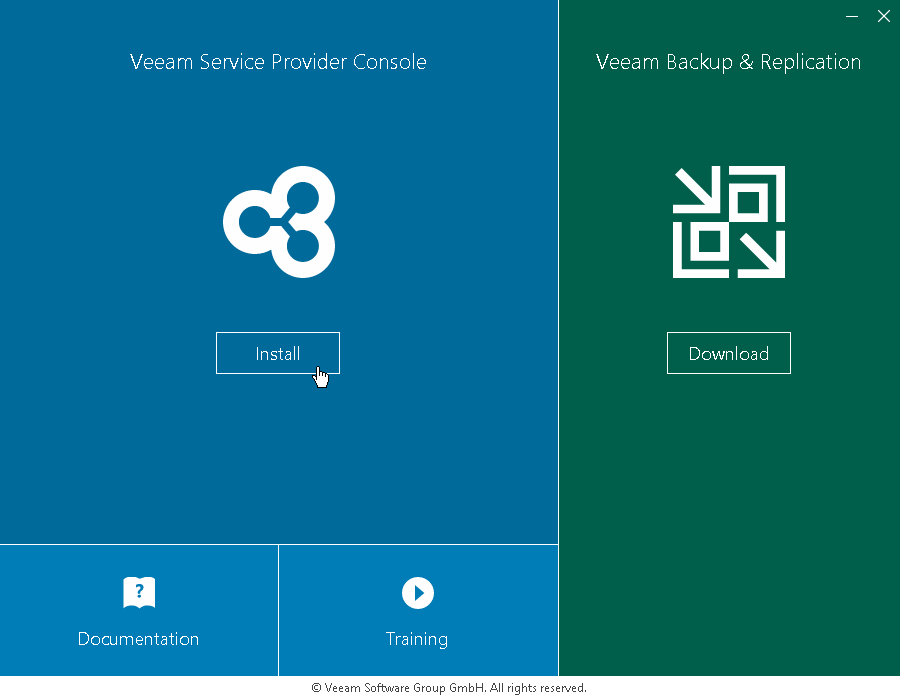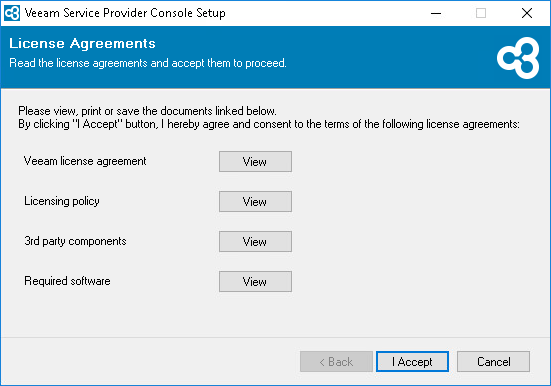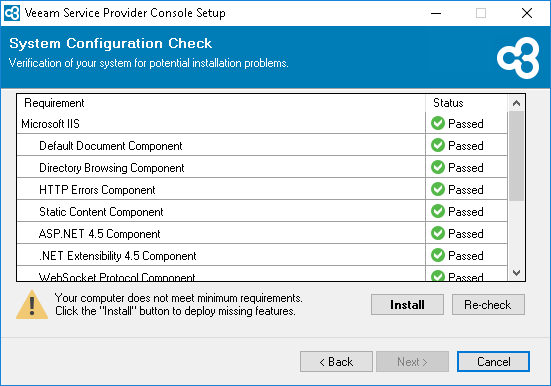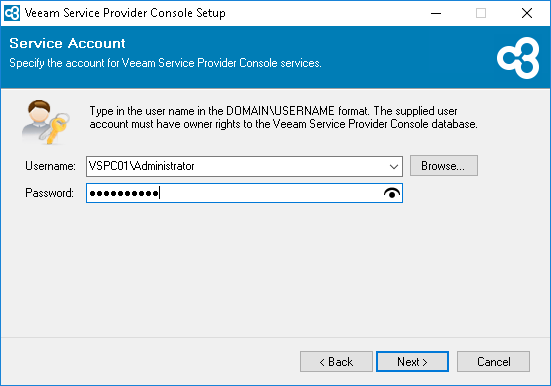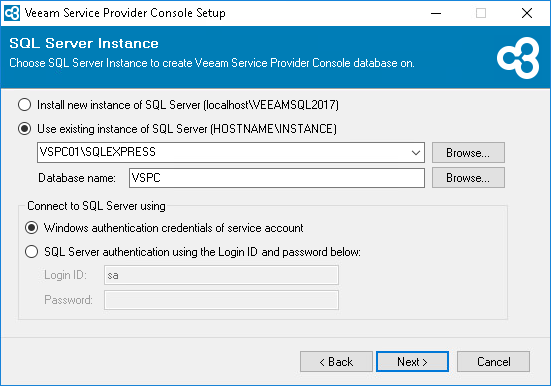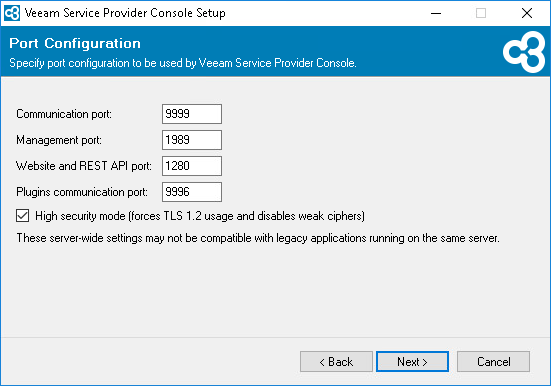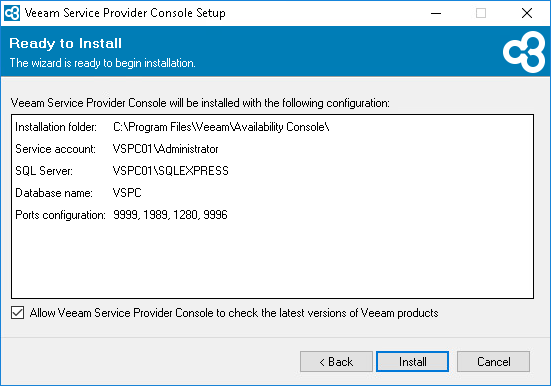You can install Veeam Availability Console on a physical or virtual machine, using the single-server installation scenario. In this scenario, the Veeam Availability Console Server and Web UI components are installed on the same machine. Single-server scenario is preferable for small- to medium-scale deployments.
Before you begin the installation process, make sure that:
- The machine where you plan to install Veeam Availability Console meets software and hardware requirements.
For details, see System Requirements.
- All required ports are open.
For details, see Ports.
To install Veeam Availability Console:
- Log on as Administrator to the machine where you want to install Veeam Availability Console.
- Mount the installation image using disk image emulation software or burn the downloaded image to a CD/DVD.
If you are installing Veeam Availability Console on a VM, use built-in tools of the virtualization management software to mount the installation image to the VM.
- Run the Setup.exe file from the image to launch the setup splash screen.
- On the splash screen, click the Install tile to launch the Veeam Availability Console Setup wizard.
|
The installer will verify what version of .NET Framework is currently present on the machine. If the required version is not found, the installer will prompt to automatically install .NET Framework that is included with the Veeam Availability Console installer. After installing .NET Framework, you might need to reboot the machine, and then continue with installation. |
- At the License Agreement step of the wizard, read and accept the license agreement.
If you choose not to accept the license agreement terms, you will not be able to continue the installation.
- At the Program Features step of the wizard, make sure that both the Server and Web UI components are selected.
If necessary, you can change the installation directory at this step.
- At the Provide License Key step of the wizard, click Browse and point to the Veeam Availability Console license file.
- At the System Configuration Check step of the wizard, check what prerequisite software is missing.
Before proceeding with the installation, the installer will perform system configuration check to determine if all prerequisite software is available on the machine. To learn what software is required for Veeam Availability Console, see System Requirements.
If some of the required software components are missing, the setup wizard will offer you to install the missing software components and enable missing features automatically. To install the missing software components and enable missing features automatically, click the Install button.
You can cancel automatic software installation. In this case, you will need to install the missing software components and enable missing features manually (otherwise, you will not be able to proceed to the next step of the setup wizard). After you install and enable all required software components, click Re-run to repeat the system configuration check.
- At the Service Account step of the wizard, type credentials of the account under which Veeam Availability Console services will run.
For requirements to the service account, see Permissions.
- At the Default Configuration step of the wizard, you can select to install Veeam Availability Console with default installation settings or specify custom installation settings.
By default, the setup wizard installs Veeam Availability Console with settings described in section Default Installation Settings.
- To use default installation settings, leave the Let me specify different settings check box cleared and click Install. The installation process will begin.
- To specify custom installation settings, select the Let me specify different settings check box. The setup wizard will include additional steps that will let you configure installation settings.
- At the SQL Server Instance step of the wizard, choose a Microsoft SQL Server instance that will host the Veeam Availability Console database.
- If you do not have a Microsoft SQL Server instance that you can use for Veeam Availability Console database, select the Install new instance of SQL Server option.
If this option is selected, the setup will install Microsoft SQL Server locally, on the machine where you are installing Veeam Availability Console.
|
If a Microsoft SQL Server instance that meets Veeam Availability Console system requirements is detected on the machine, you can only use the existing local Microsoft SQL Server instance or choose a one that runs remotely. The option to install a new Microsoft SQL Server instance will be unavailable. |
- If you want to use an existing local or remote Microsoft SQL Server instance, select the Use existing instance of SQL Server option and choose a local Microsoft SQL Server instance or browse to a Microsoft SQL Server instance running remotely. You can type the address of the Microsoft SQL Server manually or use the Browse button to choose among available remote instances.
In the Database name field, type the name of a database that will be created for Veeam Availability Console. Provide credentials of an account that will be used by Veeam Availability Console to access the database. You can specify credentials explicitly or use Windows authentication credentials of the Veeam Availability Console service account. For details on permissions required for the account, see Permissions.
- At the Port Configuration step of the wizard, specify port configuration:
- In the Communication Port field, type a number of the port on the Veeam Availability Console machine that will be used to collect data from cloud gateways and Veeam Cloud Connect server.
The default port number is 9999.
- In the Management port field, type a number of the port that the Veeam Availability Console Web UI component will use to communicate with the Server component.
The default port number is 1989.
- In the Website port field, type a number of the port that will be used to access the Veeam Availability Console website through a web browser.
The default port number is 1280.
- In the RESTful API port field, type a number of the port that will be used to interact with the Veeam Availability Console RESTful API.
The default port number is 1281.
- In the Use certificate list, choose a TLS certificate that will be used to secure traffic between Veeam Availability Console and the client application (web browser or API client application).
You can choose an existing certificate installed on the machine, or generate a new self-signed certificate. If you generate or choose a self-signed certificate, you will need to configure a trusted connection between Veeam Availability Console and the client application. For details, see Configuring Trusted Connection.
- At the Ready to Install step of the wizard, review the provided configuration settings and click Install.
- After installation completes, click Finish to exit the wizard.
If you choose to install Veeam Availability Console with the default configuration settings, the setup wizard will use the following configuration for installation:
- Installation directory: %ProgramFiles%\Veeam\Availability Console\.
- Microsoft SQL Server: LOCALHOST\VEEAMSQL2012. During installation, the setup wizard installs a new instance of Microsoft SQL Server locally on the Veeam Availability Console machine.
- Database name: VAC. The setup wizard deploys the Veeam Availability Console database on the locally installed instance of Microsoft SQL Server.
- Connection to Microsoft SQL Server: Windows authentication credentials of the service account.
- Communication port: 9999.
- Management port: 1989.
- Website port: 1280.
- RESTful API port: 1281.
- Certificate: Self-signed certificate generated during installation.


